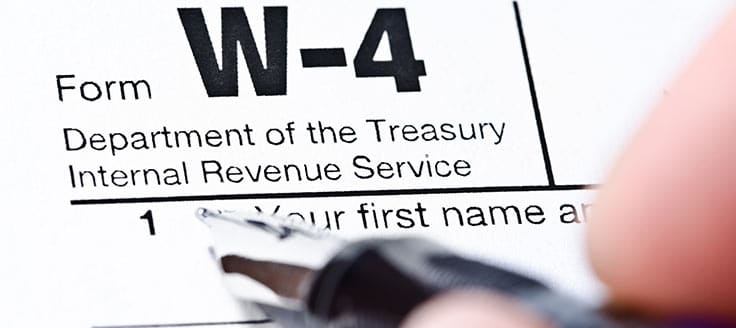Is your payroll department prepared with the latest Employee’s Withholding Certificate (Form W-4) information? As an employer, you must use the new tax document and be prepared to answer questions about how to fill out the W-4 form. Learn more about the changes and what this means for your business.
Changes to the 2020 W-4 Form
After nearly 32 years, the Internal Revenue Service (IRS) updated the W-4 form for 2020. The new tax document aligns with tax law changes implemented in 2018. Although it’s meant to simplify the process of withholding income tax, both employers and employees have questions. Fortunately, the IRS and its Advisory Council continue to update resources to help small business owners and their staff.
Why Did It Change?
In 2017, the Tax Cuts and Jobs Act passed and the changes went into effect in 2018. To ensure the accuracy of withholding amounts, the IRS revised the 1987 W-4 form. According to the IRS, the change “reduces the form’s complexity and increases the transparency and accuracy of the withholding system.”
What’s Different on the 2020 W-4?
At first glance, the new W-4 form looks completely different and more complicated. The IRS started by removing the term “allowance” from the form title.
- 1987 W-4: Employee’s Withholding Allowance Certificate
- 2020 W-4: Employee’s Withholding Certificate
The updated form no longer relies on the number of allowances, hence the name change. With the Tax Cuts and Jobs Act, personal exemptions and dependency exemptions were suspended, which made the withholding allowance portion on the old form void.
The new form takes into consideration the employee’s other jobs, investment income and even features a spot for those who itemize their tax bills. Let’s go through each change.
Step One: Filing Status Options
On the previous form, employees chose from 3 statuses: married, single or married but withhold at a higher rate. On the new document, the options include:
- Single or married filing separately
- Married filing jointly or qualifying widow
- Head of household
The updated W-4 also removes the checkbox for employees who put a different name on their W-4 form than what’s listed on their social security card. Instead, the IRS instructs the employee to contact the Social Security Administration (SSA) to ensure credit for earnings.
Step Two: Multiple Jobs or Spouse Works
This section is new. The employee is asked to choose 1 of 3 options to reflect their total income. Employees with more than 1 job or who have a working spouse should complete step 2. The 3 choices to get the withholding amount consist of:
- Use the online IRS estimator (W-4 calculator)
- Complete the multiple jobs worksheet
- Check the box if the employee and spouse have only 2 jobs total
Step Three: Claim Dependents
For steps 3 and 4, the IRS advises employees only to complete these sections for a single employer. This means that if the employee has a second job or has a working spouse, then they should only fill out these steps for the job with the highest pay. W-4 forms for other jobs should leave these steps blank.
The old form counted allowances for personal exemptions and dependents. On the 2020 W-4 form, the data factors in a dollar amount instead. Employees fill in 2 lines and calculate the amounts.
- Number of qualifying children under age 17 and multiply by $2,000
- Multiply all other dependents by $500
Step Four: Other Adjustments
This all-new section is optional and should only be completed for 1 job. Employees have 3 places to add more information for extra accuracy.
- 4(a): Other Income. Employees can add interest, retirement or dividend income and have tax withheld for these amounts
- 4(b): Deductions. For those who itemize, they complete the Deductions Worksheet and enter the result on the line
- 4(c): Extra Withholding. Similar to the old W-4 form, employees can opt to have extra money withheld from their paycheck
Step Five: Signature and Employer Information
For the most part, Section 5 is the same except for a portion that directly applies to you as the employer: You must add a “First date of employment” to the document. For current employees, you’ll have to dig into their records for an accurate date. For new employees, you’ll list their starting date of employment.
What Does This Mean for Employees?
For employees, this new form should help them avoid big surprises at tax time. But, like anything new, the 2020 Form W-4 might cause some confusion. A few things that are important to note are:
- All new hires who will receive their first paycheck in 2020 must use the 2020 W-4 form
- Current staffers aren’t required to fill out a new form, but they can opt to do so
- Only steps 1 and 5 are needed; the others are optional
The initial complexity of the new form might result in more questions of you and your payroll department — such as what is a W-4, how to fill out a W-4 and what to claim on the W-4 form. Before rolling out the new form, brush up on a few questions that employers might need to answer.

What Employers Should Know
To start, you must use the 2020 W-4 form for all new hires receiving their first paycheck in 2020. There is no grace period. You must comply with the new rules by Jan. 1, 2020. Only W-2 employees, not contractors, need to complete this tax document.
Also, your payroll services should be set up to handle the new paperwork. But, there are a few things to remember when asking new or current employees to fill out the new paperwork.
- Some employees may not want to share information about their other income with you
- Employees might need extra time to complete the updated W-4 form
- You can’t force employees hired before 2020 to complete a new document
As an employer, be prepared to answer questions and communicate effectively with your staff.
What Is a W-4 Form?
The W-4 form is a tax document. Employees fill it out so the employer knows how much money to withhold from employees’ paychecks and send to the IRS. The employer is responsible for sending the amount listed on the form, but the employee is responsible for accuracy in filling out the form.
How Do You Fill Out a W-4 Form?
The changes are likely to confuse new and current employees. Familiarize yourself with the new form, so you can walk people through the steps as needed. The IRS also includes worksheets to assist employees and offers an online W-4 calculator. To help your staff, you might want to:
- Direct employees to the IRS W-4 calculator
- Suggest staff use information from their previously filed taxes
- Share additional resources such as a letter or video
What Do You Claim on a W-4 Form?
With the number of allowances removed, employees might be unsure what to claim on the W-4 form. Be prepared to give resources about what defines a qualifying child younger than age 17 versus other dependents. As an employer, you shouldn’t give out tax advice or direct employees on what to claim. However, you can share information to help your staff make the best decision.
More Information About the W-4
If you’re unsure how to present the new information to your employees or have unanswered questions, then use the resources below to ensure a seamless transition to the new tax document.
2020 W-4 Form Resources for Employees
- 2020 Form W-4
- IRS Flyer to Post in Your Workplace
- Sample Letter Explaining the 2020 Form W-4 to Employees
- IRS’s Tax Withholding Estimator W4 Calculator
- Frequently Asked Questions About the W-4 Form











